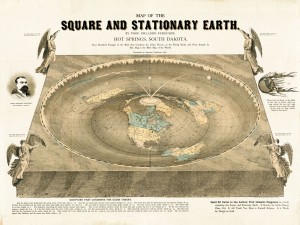If you’ve never been up in The Ames Library stacks (where we keep the books) you might realize that we some really AWESOME stuff. One of our new acquistions, for example, was recently featured in Wired Magazine.
On 10/15, Adam Mann, wrote:
What does the universe look like? How about the sun, moon, planets, and stars? These are probably question that humans have been asking themselves ever since we first looked up at the sky.
A new book, Cosmigraphics: Picturing Space Through Time, looks at the imaginative variety of ways that people have answered these questions throughout history. In it, photographer and filmmaker Michael Benson collects thousands of years of human understanding about the heavens.
 Cosmigraphics is divided into 10 chapters, each following the progression of ideas about some heavenly topic. For instance, one chapter centers around representations of the Earth. In it, you can see dramatic medieval conceptions of our planet surrounded by elemental water, air, and fire. There’s also a bizarre 19th century map refuting the theory that the Earth is sphere-shaped — instead postulating a four-cornered, roulette-wheel world more in accordance with Biblical (or something) principles. Finally, there are recent geographic drawings of river basins and ocean floors based on the enhanced technological capabilities of the modern world.
Cosmigraphics is divided into 10 chapters, each following the progression of ideas about some heavenly topic. For instance, one chapter centers around representations of the Earth. In it, you can see dramatic medieval conceptions of our planet surrounded by elemental water, air, and fire. There’s also a bizarre 19th century map refuting the theory that the Earth is sphere-shaped — instead postulating a four-cornered, roulette-wheel world more in accordance with Biblical (or something) principles. Finally, there are recent geographic drawings of river basins and ocean floors based on the enhanced technological capabilities of the modern world.
All images in the book are essentially data visualizations representing the accumulated knowledge of their time. Ancient people’s data was far more limited than ours, and mixed with erroneous beliefs about divine spirits, celestial spheres, and geocentric cosmologies. But looking back through history reminds us that our current scientific ideas no doubt contain inaccuracies and partial truths, limitations of the data at hand. With scientists still debating the inner workings of black holes, the properties of neutrinos, and the nature of dark matter and dark energy, we realize the amount we have yet to know is as vast as the universe itself.
 The book is also a good reminder of how big a deal the night sky was to pre-Industrial people. The movement of the sun and phases of the moon told them when to plant and harvest their crops. The changing stars and planets helped them interpret their own lives and their futures. Even today, you might get away from city lights and look up to feel a sense of wonder and awe, a slight tug from the collective unconscious of humanity that has been watching and thinking about the universe for so long.
The book is also a good reminder of how big a deal the night sky was to pre-Industrial people. The movement of the sun and phases of the moon told them when to plant and harvest their crops. The changing stars and planets helped them interpret their own lives and their futures. Even today, you might get away from city lights and look up to feel a sense of wonder and awe, a slight tug from the collective unconscious of humanity that has been watching and thinking about the universe for so long.
All captions from Cosmigraphics”
